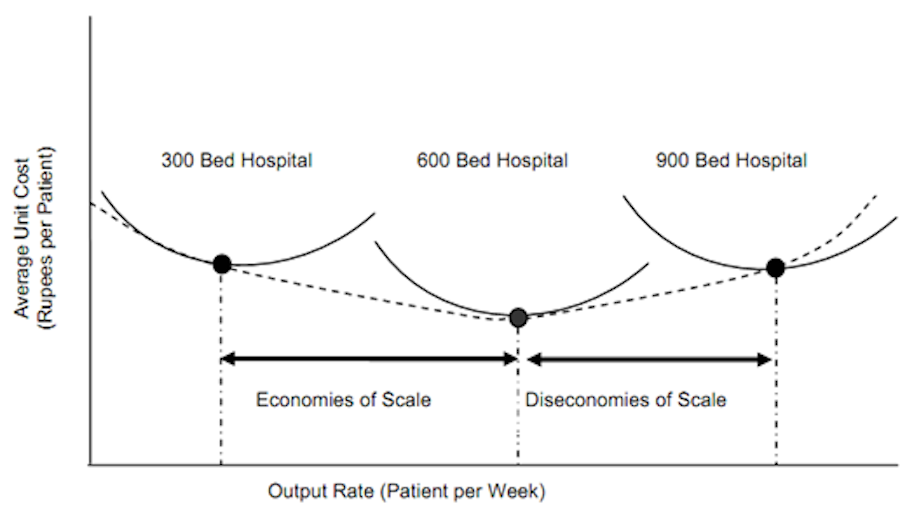Being able to benefit from economies of scale is one of the major reasons why a business aims to grow.
Economies of scale mean reductions in a firm’s unit cost of production, or Average Cost (AC) of production, as a result from increasing the scale of business operations. The scale of operations means the size of the business expressed as a business’s output. Output means the quantity of products produced (Q).
Why businesses want to achieve economies of scale?
When the business grows, or increases the scale of operations, by producing more output, it reduces Average Cost (AC) of production therefore benefits from economies of scale.
As a firm operates on a larger scale due to an improvement in productive efficiency, economies of scale can help businesses to gain a competitive cost advantage. Because lower Average Cost (AC) means two things:
- A higher profit margin earned on each unit produced and sold.
- Ability to offer lower prices to customers.
Unit costs matter for large scale production
Those reductions in costs can be very substantial in some industries that operate on a very large scale, e.g. The Coca Cola Company, Ford or Walmart.
When larger firms that produce soft drinks are able to lower their prices and gain higher profit margins, it makes them very competitive against smaller firms which will be unlikely to survive due to lack of competitiveness.
How to calculate the Average Cost?
Average Cost (AC) is the cost per unit of output. It is calculated by dividing Total Costs (TC) by the quantity of output (Q) produced:
Average Cost (AC) = Total Costs (TC) / Quantity
For example, if Total Costs (TC) of producing 1,000 cars amounts to USD$10,000,000 then the cost of producing each single car is USD$10,000.
Average Cost (AC) consist of two components: Average Fixed Cost (AFC) and Average Variable Cost (AVC). Average Fixed Cost (AFC) is calculated by dividing Total Fixed Costs (TFC) by the quantity of output (Q):
Average Fixed Cost (AFC) = Total Fixed Costs (TFC) / Quantity
Similarly, Average Variable Cost (AVC) is calculated by dividing Total Variable Costs (TVC) by the quantity of output (Q):
Average Variable Cost (AVC) = Total Variable Costs (TVC) / Quantity
So, Average Cost (AC) equals to Average Fixed Cost (AFC) plus Average Variable Cost (AVC):
Average Cost (AC) = Average Fixed Cost (AFC) + Average Variable Cost (AVC)
With larger levels of output, Average Fixed Cost (AFC) of a firm will decline continuously. This is because while Total Fixed Costs (TFC) remain constant they are spread over an increasing amount of output (Q). So, the same Fixed Costs (FC) are being divided by a larger and larger number of products produced (Q).
What is the ideal size of the business?
Economies of scale reduce Average Cost (AC) of producing one product and diseconomies of scale increase Average Cost (AC). The combined effect of economies of scale and diseconomies of scale on a unit cost of production is shown below.
The Average Cost (AC) curve is U-shaped. You can see that as output increases, unit costs fall and continue to do so until diseconomies of scale occur, and the unit cost begins to rise. The ‘best’ scale of operation is where the unit cost is at the lowest level – the big black dot for each hospital, and at the bottom of the dotted curve.
So, the optimal level of output (Q) is always there where Average Cost (AC) is the lowest.

Can economies of scale last forever?
Certain economies of scale may continue taking place as the business increases its scale of operations over a certain period of time.
However, it is important to emphasize that it is often impossible to determine exactly at what level of output (Q) economies of scale stop and diseconomies of scale begin.
It is simply quite difficult to pinpoint that specific point for managers who may continue to expand the business not being aware that diseconomies have already been building up for a while. As the growing significance of diseconomies gradually begins to take over, Average Cost (AC) will start rising. Therefore, most of the expanding businesses will eventually experience diseconomies of scale sooner or later.
This explains why most industries are not dominated by just one or few firms. It is simply not very beneficial for the business to be too large.
Two different types of economies of scale
Internal economies of scale are economies of scale that occur inside the firm and are within its control.
External economies of scale are economies of scale that occur within the industry (outside the firm) and are largely beyond an individual firm’s control.
 Articles: 1,400 · Readers: 740,000 · Views: 2,209,961
Articles: 1,400 · Readers: 740,000 · Views: 2,209,961 